
Charlotte is the most populous city in the U.S. state of North Carolina and the county seat of Mecklenburg County. The population was 874,579 at the 2020 census, making Charlotte the 15th-most populous city in the United States, the seventh-most populous city in the South, and the second-most populous city in the Southeast behind Jacksonville, Florida. Charlotte is the cultural, economic, and transportation center of the Charlotte metropolitan area, whose estimated 2023 population of 2,805,115 ranked 22nd in the United States. The Charlotte metropolitan area is part of an 18-county market region and combined statistical area with an estimated population of 3,387,115 as of 2023.

Mecklenburg County is a county located in the southwestern region of the U.S. state of North Carolina, in the United States. As of the 2020 census, the population was 1,115,482, making it the second-most populous county in North Carolina, and the first county in the Carolinas to surpass one million in population. Its county seat is Charlotte, the state's largest municipality.

Digitization is the process of converting information into a digital format. The result is the representation of an object, image, sound, document, or signal obtained by generating a series of numbers that describe a discrete set of points or samples. The result is called digital representation or, more specifically, a digital image, for the object, and digital form, for the signal. In modern practice, the digitized data is in the form of binary numbers, which facilitates processing by digital computers and other operations, but digitizing simply means "the conversion of analog source material into a numerical format"; the decimal or any other number system can be used instead.

Richard A. Vinroot is an American politician and attorney from Charlotte, North Carolina. He served as the 52nd Mayor of Charlotte from 1991 to 1995. Vinroot ran unsuccessfully for Governor of North Carolina in 1996, 2000 and 2004. The City of Charlotte's Richard Vinroot International Achievement Award is named in his honor.
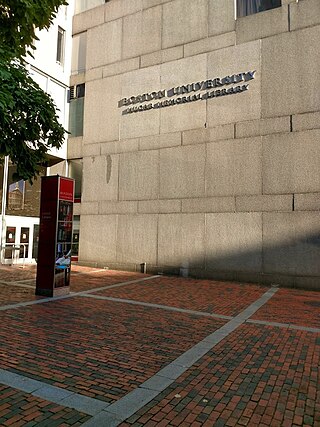
The Mugar Memorial Library is the primary library for study, teaching, and research in the humanities and social sciences for Boston University. It was opened in 1966. Stephen P. Mugar, an Armenian immigrant who was successful in the grocery business, provided the naming gift to commemorate his parents. Mugar's entrance carries an inscription from Stephen honoring his parents.
In coming to America from Armenia my parents opened the door of Freedom to me. America's public schools & libraries opened my eyes to the unlimited opportunity in this great land, as well as the privileges and obligations of citizenship. May this library serve over the years as a similar inspiration to all who use it. In memory of my father and mother Sarkis and Vosgitel Mugar. By their grateful son
– Stephen P. Mugar –
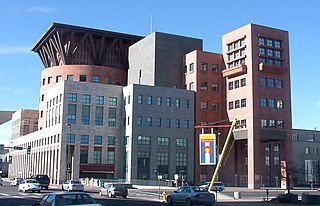
The Denver Public Library is the public library system of the City and County of Denver, Colorado. The system includes the Denver Central Library, located in the Golden Triangle district of Downtown Denver, as well as 25 branch locations and two bookmobiles. The library's collection totals more than 2 million items, including books, reference materials, movies, music, and photographs. Of that total, more than 347,000 items are in specific collections including the Western History and Genealogy Department, Blair-Caldwell African American Research Library, and Reference Department holdings.

Uptown Charlotte, also called Center City, is the central business district of Charlotte, North Carolina, United States. The area is split into four wards by the intersection of Trade and Tryon Streets, and bordered by Interstate 277 and Interstate 77. The area is managed and overseen by the Charlotte Central City Partners, which is one of the three Municipal Service Districts in Charlotte. Uptown Charlotte is the largest business district in Charlotte and the Carolinas.

Harding University High School is located at 2001 Alleghany Street, in Charlotte, North Carolina. It was established as a Math, Science, and Technology school in 1992, and added an International Baccalaureate to its program in 1995.

The Charlotte Mecklenburg Library is the public library system of the city of Charlotte and Mecklenburg County in North Carolina, United States.
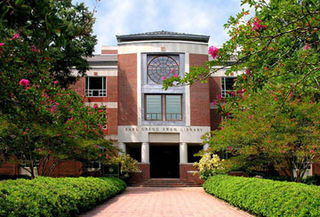
The Earl Gregg Swem Library is located on Landrum Drive at the College of William and Mary in Williamsburg, Virginia. The library is named for Earl Gregg Swem, College Librarian from 1920-1944. In 2008, the Princeton Review rated William & Mary's library system as the eighth best in the United States. The ranking was based on a survey of 120,000 students from 368 campuses nationwide.
The Mint Museum, also referred to as The Mint Museums, is a cultural institution comprising two museums, located in Charlotte, North Carolina. The Mint Museum Randolph and Mint Museum Uptown, together these two locations have hundreds of collections showcasing art and design from around the globe.

The John Hay Library is the second oldest library on the campus of Brown University in Providence, Rhode Island, United States. It is located on Prospect Street opposite the Van Wickle Gates. After its construction in 1910, the Hay Library became the main library building on campus, replacing the building now known as Robinson Hall. Today, the John Hay Library is one of five individual libraries that make up the University Library. The Hay houses the University Library's rare books and manuscripts, the University Archives, and the Library's special collections.
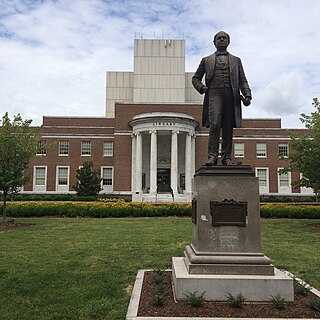
The University of North Carolina at Greensboro University Libraries system has two branches on campus, both located in Greensboro, NC. These include the Walter Clinton Jackson Library and the Harold Schiffman Music Library. Affiliated campus libraries include the Teaching Resource Center and SELF Design Studio in the School of Education, the Interior Architecture Library in the Gatewood Studio Arts Building, and the Intercultural Resource Center located in the Elliot University Center. During the fall and spring semesters, Jackson Library provides a 24/5 study space for UNCG students, faculty and staff with UNCG ID from 12 am Monday – 7:00 am Friday. Michael A. Crumpton is the current Interim Dean of the libraries.
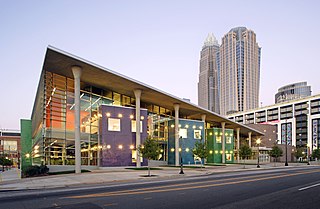
ImaginOn: The Joe and Joan Martin Center is a collaborative venture of Charlotte Mecklenburg Library and the Children's Theatre of Charlotte located in Charlotte, North Carolina. This 102,000-square-foot (9,500 m2) landmark learning center opened on October 8, 2005. ImaginOn was designed by Gantt Huberman Architects and Holzman Moss Bottino Architecture, and is owned by the Charlotte Mecklenburg Library.

The Rare Book and Manuscript Library is principal repository for special collections of Columbia University. Located in New York City on the university's Morningside Heights campus, its collections span more than 4,000 years, from early Mesopotamia to the present day, and span a variety of formats: cuneiform tablets, papyri, and ostraca, medieval and Renaissance manuscripts, early printed books, works of art, posters, photographs, realia, sound and moving image recordings, and born-digital archives. Areas of collecting emphasis include American history, Russian and East European émigré history and culture, Columbia University history, comics and cartoons, philanthropy and social reform, the history of mathematics, human rights advocacy, Hebraica and Judaica, Latino arts and activism, literature and publishing, medieval and Renaissance manuscripts, oral history, performing arts, and printing history and the book arts.
The Tampa–Hillsborough County Public Library System (THPL) is a public library system based in Hillsborough County, Florida. THPL is part of two larger library networks, the Tampa Bay Library Consortium, and the Hillsborough County Public Library Cooperative which includes Temple Terrace Public Library in Temple Terrace, Florida, and Bruton Memorial Library in Plant City, Florida. There are 33 branches of the Hillsborough County Public Library Cooperative. Services provided by the THPL include internet access, public meeting room spaces, interlibrary loans, a Bookmobile, a Cybermobile for Spanish speakers, technology classes, adult literacy programs, and downloadable eBooks. Drive-thru windows for returns and hold pick-ups are located at the Jimmie B. Keel and the Jan Kaminis Platt Regional Libraries. In 2017, THPL introduced the new HAAL Pass, which gives access to certain library resources to all students in the Hillsborough County Public Schools System. Students use their student ID number to use different online databases, borrow up to three physical items and read eBooks. The Tampa–Hillsborough County Public Library System is also a part of Hillsborough County government. On January 1, 2018, the library cooperative became one of the largest in the country to go fine free. Overdue fees for borrowed materials were eliminated with the implementation of the "Just Bring It Back" initiative. In 2019 the cooperative received the FLA Library of the Year Award. Tampa-Hillsborough County Public Library was recognized for its community focused initiatives as it "reorganized its staffing model and eliminated overdue fines, yielding $1 million in savings while increasing access to library resources and expanding opportunities for community engagement through unique, scalable programs."

The Louis Round Wilson Library is a library at the University of North Carolina at Chapel Hill. Completed in 1929, it served as the university's main library until 1984. Today, it houses several special collections. The dome rises 85 feet over the university's South Quadrangle.

The Rare Book and Manuscript Library at the University of Illinois Urbana-Champaign is located on the 3rd floor of the University Library. The library is one of the largest special collections repositories in the United States. Its collections, consisting of over half a million volumes and three kilometers of manuscript material, encompass the broad areas of literature, history, art, theology, philosophy, technology and the natural sciences, and include large collections of emblem books, writings of and works about John Milton, and authors' personal papers.
Founded in 1916, the Columbia County Historical Society and CCHS Museum & Library collects, preserves, interprets, and presents the history, heritage, and culture of Columbia County, New York, and serves residents of all eighteen Columbia County towns and the city of Hudson.

The Main Library of the Columbus Metropolitan Library (CML) system is located in Downtown Columbus, Ohio, United States. The public library is the largest in the library system and holds approximately 300,000 volumes. It includes numerous rooms, including separate spaces for children, teens, an adult reading room, newspaper room, auditorium, gallery, gift shop, and a cafe. The third floor includes a computer lab and houses the Franklin County Genealogical & Historical Society.
















